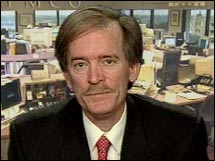Tough love on Wall StreetAs lenders hunt for bad loans, Pimco founder and Fortune columnist Bill Gross says the Street is learning hard lessons about disclosure.(Fortune Magazine) -- During times of market turmoil it helps to simplify and talk basics -- explain things to the public and even yourself in terms of what can be easily understood. Goodness knows, it's not a piece of cake for anyone over 40 these days to understand the maze of financial structures that now appears to be unwinding. They were created by youthful financial engineers trained to exploit cheap money and leverage, who showed no fear and who have, until the past few weeks, never known the sting of the market's lash.
They are wizards of complexity. I, however, having just turned 63, am a professor of simplicity. So forgive the perhaps unsophisticated explanation that follows of the way the subprime crisis swiftly crossed the borders of mortgage finance to infect global capital markets. What Citigroup's Chuck Prince, the Fed's Ben Bernanke, Treasury Secretary Hank Paulson, and a host of other sophisticates should have known is that the bond and stock market problem is the same one puzzle players confront during a game of "Where's Waldo?" -- Waldo in this case being the bad loans and defaulting subprime paper of the U.S. mortgage market. While market analysts can estimate how many Waldos might actually show their faces over the next few years -- $100 billion to $200 billion worth is a reasonable estimate -- no one really knows where they are hidden. First believed to be confined to Bear Stearns's hedge funds and their proxies, Waldos have been popping up with regularity in seemingly staid institutions such as German and French banks, and that has necessitated state-sanctioned bailouts reminiscent of the Long-Term Capital Management crisis of 1998. IKB, a German bank, and BNP Paribas, its French counterpart, encountered subprime meltdowns on either their own balance sheets or investment funds sponsored by them. Their combined assets total billions, although their Waldos are yet to be computed or even found. Those looking for clues to the extent of the spreading fungus should understand that there really is no comprehensive data to allow anyone to know how many subprimes actually rest in individual institutional portfolios. Regulators have been absent from the game, and information release has been left in the hands of individual institutions, some of which have compounded the uncertainty with comments about volatile market conditions unequaled during the lifetime of their careers. Also many institutions, including pension funds and insurance companies, argue that accounting rules allow them to mark subprime derivatives at cost. Default exposure, therefore, can hibernate for many months before its true value is revealed to investors and, importantly, to other lenders. The significance of proper disclosure is, in effect, the key to the current crisis. Financial institutions lend trillions of dollars, euros, pounds, and yen to and among one another. In the U.S., for instance, the Fed lends to banks, which lend to prime brokers such as Goldman Sachs (Charts, Fortune 500) and Morgan Stanley (Charts, Fortune 500), which lend to hedge funds, and so on. The food chain in this case is not one of predator feasting on prey, but a symbiotic credit extension, always for profit, but never without trust and belief that their money will be repaid upon contractual demand. When no one really knows where and how many Waldos there are, the trust breaks down, and money is figuratively stuffed in Wall Street and London mattresses as opposed to extended into the increasingly desperate hands of hedge funds and similarly levered financial conduits. These structures in turn are experiencing runs from depositors and lenders exposed to asset price declines of unexpected proportions. In such an environment, markets become incredibly volatile as more and more financial institutions reach their risk limits at the same time. Waldo morphs and becomes a man with a thousand faces. All assets, with the exception of U.S. Treasuries, look suspiciously like one another. They're all Waldos now. The past few weeks have exposed a giant crack in modern financial architecture, created by youthful wizards and endorsed for its diversity by central bankers present and past. While the newborn derivatives may hedge individual institutional and sector risk, they cannot eliminate the Waldos. In fact, the inherent leverage that accompanies derivative creation may foster systemic risk when information is unavailable or delayed in its release. Nothing within the current marketplace allows for the hedging of liquidity risk, and that is the problem at the moment. Only the central banks can solve this puzzle, with their own liquidity infusions and perhaps a series of rate cuts. The markets stand by with apprehension. |
Sponsors
|

